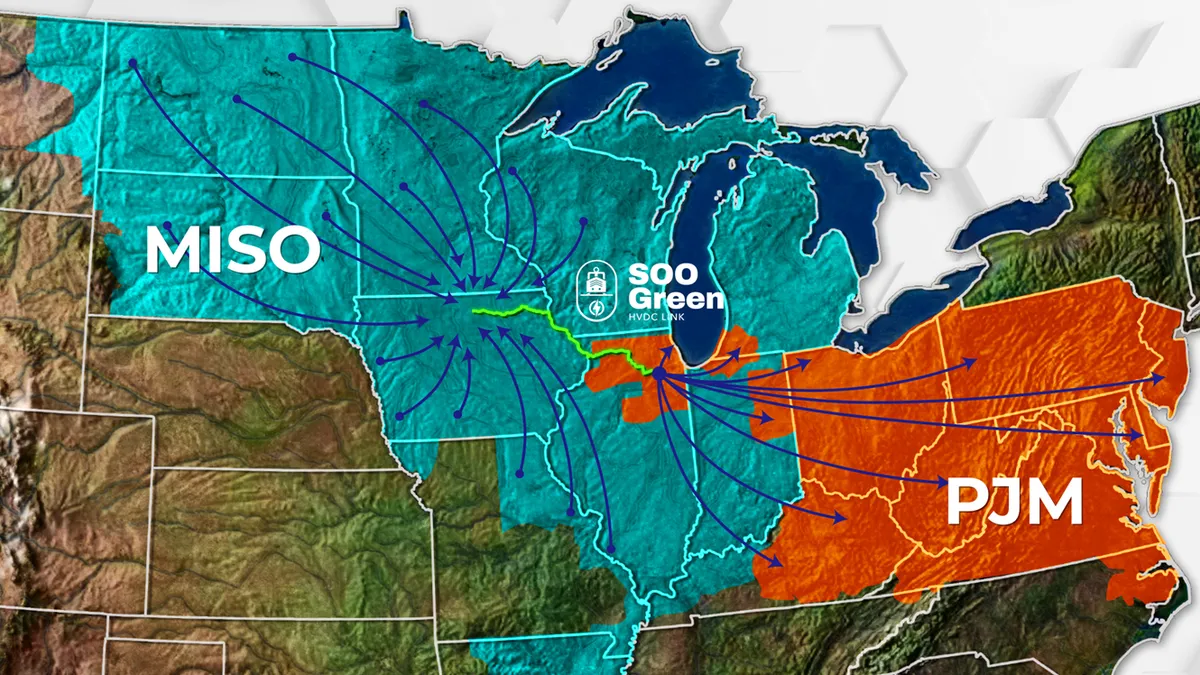Dive Brief:
-
The PJM Interconnection and its independent market monitor urged the Federal Energy Regulatory Commission to dismiss a complaint by the developers of the $2.5 billion SOO Green interstate transmission project, saying the developers are trying to upend the grid operator's capacity rules for generating resources outside its footprint.
-
SOO Green's proposal would "subvert" the PJM's capacity market, hurting grid reliability and lowering capacity prices by crowding out resources that meet the grid operator's capacity requirements, Monitoring Analytics said in a FERC filing Monday.
-
The Natural Resources Defense Council supported SOO Green's complaint, which the advocacy group said would boost market competition by supporting innovative technology.
Dive Insight:
SOO Green's complaint filed last month is its second attempt to get FERC to help pave the way for a 350-mile underground, direct-current power line that could transfer 2,100 MW between the Midcontinent Independent System Operator (MISO) and PJM (EL21-103).
SOO Green in June argued that PJM's process for considering merchant transmission lines was flawed and was delaying the power line, which would follow Canadian Pacific railroad rights of way between Mason City, Iowa, and Yorkville, Illinois (EL21-85).
In the most recent complaint, SOO Green said PJM's rules for capacity outside its footprint block market entry and stifle competition without providing significant reliability benefits.
Currently, external resources can participate in PJM's capacity market only if the grid operator can directly dispatch them.
Under SOO Green's proposal, PJM would send a dispatch signal to the transmission line, which in turn would draw power from MISO's system, but not from any specific generating source. Resources in MISO that use SOO Green's "controllable" high-voltage direct current line would be eligible to bid in PJM's capacity auctions.
Monitoring Analytics said the proposal would strip away rules designed to make sure external generating resources actually provide their capacity when the grid operator needs it.
"Rather than enhancing reliability, this [transmission] project would undermine reliability by replacing resources subject to PJM control and dispatch with resources subject to MISO control and dispatch," the market monitor said.
SOO Green wants FERC to ignore commission precedent supporting PJM's existing external capacity requirements, the grid operator said in a Friday filing at FERC.
Direct Connect, the developer of the transmission project, dismissed the concerns raised by PJM and its market monitor.
"Since the HVDC line is controllable, PJM can directly dispatch SOO Green to get the energy and capacity they need while relying on dedicated resources that will be held to the same performance standards as any other PJM capacity resource," said Steve Frenkel, vice president of Direct Connect.
Generating resources without those obligations would have a competitive edge over all other PJM capacity resources and would have an incentive to offer a lower price for an inferior product, according to PJM, which runs the grid and wholesale power markets in 13 mid-Atlantic and Midwestern states and the District of Columbia.
SOO Green is seeking preferential treatment, according to Exelon and J-POWER USA Development, companies with power plants in PJM's footprint that asked FERC to dismiss the complaint.
The Natural Resources Defense Council and the Sustainable FERC Project supported SOO Green, saying PJM would be able to directly schedule the flows on the transmission line to meet market and reliability demands.
"PJM's external capacity rules are a holdover from addressing concerns with old technology, not an intrinsic need for capacity markets," the groups said.
SOO Green, based in St. Louis Park, Minnesota, is owned by Copenhagen Infrastructure Partners, Jingoli Power Transmission, Siemens Energy and PPL Corp.
Editor's note: We have updated this article to add comments from the developer of SOO Green that came in after we published it.














